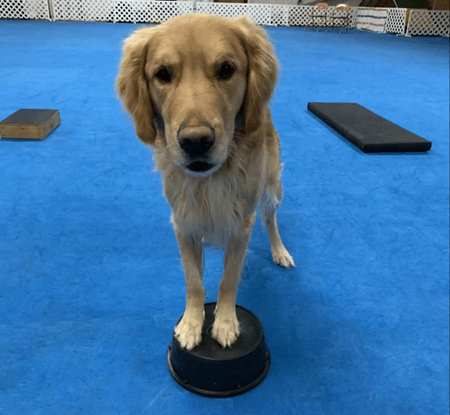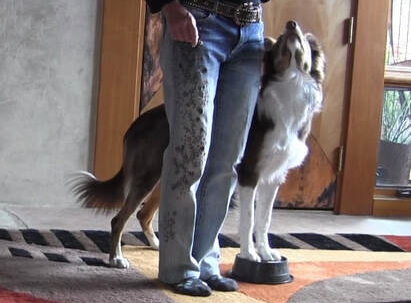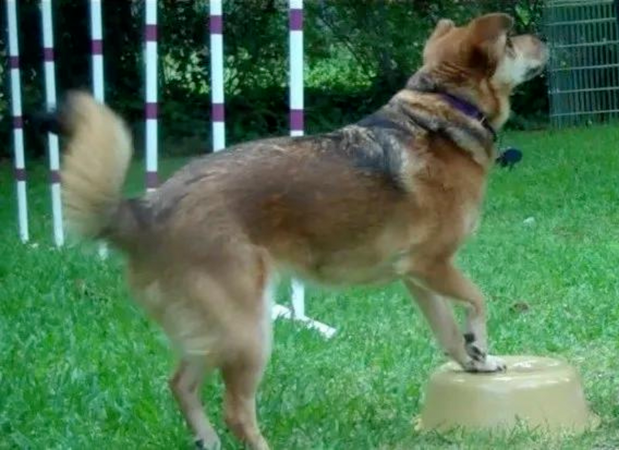Advanced Dog Obedience Training: Pivot Training
Advanced Puppy Obedience Training
If you want an easy way to teach tight turns for an eventually trained Trick Dog or simply for personal training purposes, a great way to begin is by teaching them to pivot. You may not realize that you can start training your dog in this area when they are young, but it is a beneficial skill to train for many reasons including that it can improve their ability to focus and help grow their confidence. It is a core foundation when working towards teaching and "heeling", as well helps them learn rear foot awareness overall. Dogs' rear feet follow their front feet automatically unless taught to utilize their rear feet separately. This will help strengthen their awareness of proper rear leg placement and their heel position.
To begin, you'll need a pivot perch (it doesn't necessarily have to be an official piece of equipment, a single-step step stool or large round rubber dog bowl turned upside-down will do), and- of course- treats. The more motivating, the better- this is a great time to whip out the special occasion treats. Cheese or pieces of chicken are great options! During this process it is beneficial for you, as the dog trainer, to stand so you have a better vantage point to observe your dog's movements and the ability to quickly reward desired behavior or positioning. A mirror can aid in viewing them from more angles simultaneously.
Speak With A Dog
Training Expert
Speak With A Dog Training Expert
Thank you for contacting us!
We will contact you shortly!
Please try again later.
Advanced Puppy Obedience Training
If you want an easy way to teach tight turns for an eventually trained Trick Dog or simply for personal training purposes, a great way to begin is by teaching them to pivot. You may not realize that you can start training your dog in this area when they are young, but it is a beneficial skill to train for many reasons including that it can improve their ability to focus and help grow their confidence. It is a core foundation when working towards teaching and "heeling", as well helps them learn rear foot awareness overall. Dogs' rear feet follow their front feet automatically unless taught to utilize their rear feet separately. This will help strengthen their awareness of proper rear leg placement and their heel position.
To begin, you'll need a pivot perch (it doesn't necessarily have to be an official piece of
Speak With A Dog
Training Expert
Speak With A Dog Training Expert
Thank you for contacting us!
We will contact you shortly!
Please try again later.
equipment, a single-step step stool or large round rubber dog bowl turned upside-down will do), and- of course- treats. The more motivating, the better- this is a great time to whip out the special occasion treats. Cheese or pieces of chicken are great options! During this process it is beneficial for you, as the dog trainer, to stand so you have a better vantage point to observe your dog's movements and the ability to quickly reward desired behavior or positioning. A mirror can aid in viewing them from more angles simultaneously.
Advice From A Pivot Dog Trainer
The first step is to train them to put their front paws on the pivot perch on command. You can lure them in front of the perch with a treat, then- once they're in front of it- hold the treat above their nose and raise it up slightly away from them so that they step onto the object to get to it. Once their front paws are on, praise and reward. After succeeding at this a few times, you can begin to use the cue "paws up" or whichever phrase works for you and your dog. Praise and give them a treat each time. Eventually you'll be able to give the command without the treat in front of them.
The next step, once their front paws are on the pivot object, is to stand on their right so that they are in heel position on your left side. "Heel position" is when your dog walks beside you, with its head lined up with your leg, no more than 6 inches away from you. In competitions, this is almost always on your left side. Hold a treat on their nose, they can nibble or lick it. Move slightly right or left, keeping the treat on their nose wherever you want their head to be in heel position. When their head moves, their body will follow. If their rear feet move even a little, praise and reward.
Advice From A Pivot Dog Trainer
The first step is to train them to put their front paws on the pivot perch on command. You can lure them in front of the perch with a treat, then- once they're in front of it- hold the treat above their nose and raise it up slightly away from them so that they step onto the object to get to it. Once their front paws are on, praise and reward. After succeeding at this a few times, you can begin to use the cue "paws up" or whichever phrase works for you and your dog. Praise and give them a treat each time. Eventually you'll be able to give the command without the treat in front of them.
The next step, once their front paws are on the pivot object, is to stand on their right so that they are in heel position on your left side. "Heel position" is when your dog walks beside you, with its head lined up with your leg, no more than 6 inches away from you. In competitions, this is almost always on your left side. Hold a treat on their nose, they can nibble or lick it. Move slightly right or left, keeping the treat on their nose wherever you want their head to be in heel position. When their head moves, their body will follow. If their rear feet move even a little, praise and reward.
Although you may be excited and want to get them to take several steps, it's important to not rush a foundation skill. Be very intentional, and once they're comfortable pivoting beside you, you can begin using a cue like "step" or "pivot". Next time you train, work on the steps in the opposite direction. Train both directions equally, but only one per session. You can even use "left" and "right" as the pivot cues if you want to ensure they'll understand exactly what you're wanting immediately without additional direction. However, it's not completely necessary because they will learn to read other cues from your body language.
Finally, phase out treats with repetition and the use of cues. The more they master this skill and gain confidence, the more they will be able to perform without receiving a treat. With these steps, they'll be well on their way to completing a full pivot circle in no time. For anyone looking to go beyond basic tricks, working with
professional dog trainers in Corpus Christi can help refine these skills and strengthen communication between you and your dog.
Although you may be excited and want to get them to take several steps, it's important to not rush a foundation skill. Be very intentional, and once they're comfortable pivoting beside you, you can begin using a cue like "step" or "pivot". Next time you train, work on the steps in the opposite direction. Train both directions equally, but only one per session. You can even use "left" and "right" as the pivot cues if you want to ensure they'll understand exactly what you're wanting immediately without additional direction. However, it's not completely necessary because they will learn to read other cues from your body language.
Finally, phase out treats with repetition and the use of cues. The more they master this skill and gain confidences, they more they will be able to perform without receiving a treat. With these steps, they'll be well on their way to completing a full pivot circle in no time!



